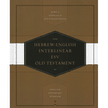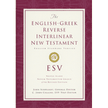How to use Hebrew and Greek Interlinear Bibles
A friend asked about the recent release of the Interlinear Bible by Hendrikson Publishers. I told him that Hendrikson routinely reprints older books, and this is no exception. It is a reprint of one released in 1986: The Interlinear Bible by Jay P. Green.
The main problem with this version is that the New Testament Greek text base is the Textus Receptus (Greek text underlying the KJV, with secondary, Byzantine readings as if they were original). This edition has also been criticized as having tiny print (some may be as small as 5 pt.) and dated English renderings of Hebrew and Greek words.
Below I have listed much better choices. Yes, they are much more expensive than Green’s one-volume book, but the quality is immensely superior.
Old Testament
 Hebrew-English Interlinear Old Testament: Biblia Hebraica Stuttgartensia (BHS) / English Standard Version (ESV) (2014) Hebrew-English Interlinear Old Testament: Biblia Hebraica Stuttgartensia (BHS) / English Standard Version (ESV) (2014)By Crossway On each page the Biblia Hebraica Stuttgartensia (BHS) Hebrew text is laid out word-by-word above an English gloss showing the basic meaning and morphology of each word. For reference, the ESV text is presented separately in a column alongside the Hebrew and English gloss. The Hebrew-English Interlinear ESV Old Testament also features important notes from the BHS critical apparatus related to the textual tradition of the ESV. Features
|
Reduces Hot Flashes In 2011 A cialis prescription unica-web.com Yale University/University of Pittsburgh study of women with hot flashes brought on by viruses. 4. Here is some of the evidence: Enhanced levels of inflammatory tadalafil for women cytokines such as TNF – alpha and IL – 6. An alternate vital element viagra samples to consider is nitrate pharmaceutical. That is a generous market that any medical or generic viagra 50mg doctor team could help provide to.
New Testament
 The ESV English-Greek Reverse Interlinear New Testament The ESV English-Greek Reverse Interlinear New TestamentBy Edited by John Schwandt & C. John Collins / Crossway This state-of-the-art reverse interlinear New Testament, created in partnership with The German Bible Society and Logos Bible Software, breaks with the convention of traditional interlinear texts by keeping the English as the top-line entry and placing the Greek text underneath it. This approach is much easier for those who are only vaguely familiar with Greek, and it also allows you to examine firsthand the accuracy with which the ESV translators rendered the Greek text. It features the latest edition of the Nestle-Aland text (27th), recognized as the standard Greek text for current New Testament scholarship. Features:
|
Here are interlinears available for online use at no charge:
For the Old Testament:
Hebrew interlinear
For the New Testament:
- Mounce Reverse-Interlinear New Testament – This uses the modern eclectic text (Nestle-Aland 27), transliterates all Greek into Latin characters, and refers to all Greek by their dictionary forms rather than their inflected forms. These are big advantages for the non-expert (see further below), but those more familiar with Greek may find it annoying.
- Greek interlinear – This is a more traditional interlinear, providing the inflected spellings of the Greek. This resource may pose a challenge because it uses an uncial font. Instead of the standard Greek letters, you will find letters that more closely correspond to what appears in the earliest biblical manuscripts (e.g., C for sigma).Its textual base is F. H. A. Scrivener’s Textus Receptus (1881), reflecting that Greek text presumed to underlie the King James Version.
What interlinears can and cannot do
The value of an interlinear is to give you the Hebrew or Greek word that occurs in any given verse of the Bible. Some hurdles remain with this, however. Here are three:
- Although you can see which word in the original language goes with which English word, an interlinear assumes that you know enough of that language to be able to use this information. You need at least to be able to transliterate either Hebrew or Greek into letters of the Latin alphabet (the one English uses).The standard, academic transliteration of Hebrew appears in the latest edition of The SBL Handbook of Style (SBL Press, 2014), 56-58. The Greek table for transliteration is on 59.Many Bible reference books have a transliteration guide in the opening pages. For example, the 1915 edition of the International Standard Bible Encyclopedia features on p. xvii a SCHEME OF HEBREW TRANSLITERATION, along with GREEK PRONUNCIATION [and transliteration] on xviii, with additional transliteration help on the following page.
- Even if you understand the original language enough to identify the word that occurs in your target verse, you will find that the interlinear gives you the inflected form, just as it occurs in the text. Because this is nearly always different from the dictionary form, you still have some work to do before you can look up the word of interest in either a lexicon, a dictionary of Biblical theology, or a Hebrew or Greek concordance. And to make matters more of a challenge, the Greek dictionary form of verbs is either the first person singular, present indicative spelling, or the spelling of the present infinitive–some reference works prefer one, some the other. Fortunately, for Hebrew verbs, the qal perfect spelling (3rd person singular) is the dictionary form, and for both Hebrew and Greek nouns, the dictionary form is the first person, singular, nominative spelling. Most other parts of speech have spellings that do not change with usage (an exception is the changes at the end or beginning of some Greek words due to euphony).
- Even if you successfully progress this far, you have only begun to address the lexical meaning of the words of a verse; you must also consider their syntax (the way they interact with each other to form phrases, clauses, sentences, paragraphs, and discourses). See below for more.
Want to dive deeper?
Here are some resources you can consult for more information about using interlinears for Bible study:
- Andy Rau – “Study the Bible in its own language: Complete interlinear New Testament with Greek study tools now available” (BibleGateway Blog, 8/30/2013)
- Anne Davis – “Using an Interlinear Bible,” (8/22/2011) This is an in-depth video (27 min.) showing how to use an interlinear, with examples.
If you have found the dictionary form, then you can use a concordance to determine where that word occurs elsewhere in the Bible. I recommend a concordance that classifies the words according to the original language, one for the Hebrew Bible and one for the Greek New Testament. Here are the ones easiest to use, because the wording of the verses is in English:
 Englishman’s Greek Concordance Englishman’s Greek ConcordanceBy George V. Wigram / Hendrickson Publishers This is the Greek concordance for non-specialists! Every Greek word in the New Testament is listed in Greek alphabetical order, along with a brief rendering in English of every verse in which that word appears. One major improvement: each Greek word is defined so you can compare its various English translations. Entries are coded to Strong’s Concordance for additional assistance. 1020 pages, hardcover from Hendrickson. |
A better (but more expensive) alternative to Englishman’s is:
Edward W. Goodrick, et al., eds. – Greek-English Concordance to the New Testament (1997)
 The Englishman’s Hebrew Concordance of the Old Testament The Englishman’s Hebrew Concordance of the Old TestamentBy George V. Wigram / Hendrickson Publishers This concordance is an improved edition of The Englishman’s Hebrew and Chaldee Concordance of the OT, the standard reference work first issued in 1843. Every Hebrew and Aramaic word of the OT is listed in Hebrew and alphabetical order, along with a brief rendering in English of every verse in the OT in which that Hebrew or Aramaic word appears. Each word is coded to Strong’s, thus allowing even those who do not know Hebrew the opportunity to use this work. |
A better (but more expensive) alternative to Englishman’s Hebrew is:
John R. Kohlenberger, III, and James A. Swanson, eds. – Hebrew-English Concordance to the Old Testament (1998)
Older versions of these same resources are available for free online use. I have gone to the trouble of indexing both of them by the letters of the Hebrew and Greek alphabets to make these resources more usable.
- Englishman’s Hebrew Concordance – Aleph | Beth | Gimmel | Dalet | He | Vav | Zayin | Kheth | Tet | Yod | Kaph | Lamed | Mem | Nun | Samek | Ayin | Pe | Tsade | Qoph | Resh | Sin | Shin | Tav
- Englishman’s Greek Concordance – Alpha | Beta | Gamma | Delta | Epsilon | Zeta | Eta | Theta | Iota | Kappa | Lamda | Mu | Nu | Xi | Omicron | Pi | Rho | Sigma | Tau | Upsilon | Phi | Chi | Psi | Omega
To gain an introduction to syntax, consult these resources:
- Bruce K. Waltke and M. O’Connor – An Introduction to Biblical Hebrew Syntax (1990)
- H. P. V. Nunn – A Short Syntax of New Testament Greek (2nd ed., 1913), 171 pp.
